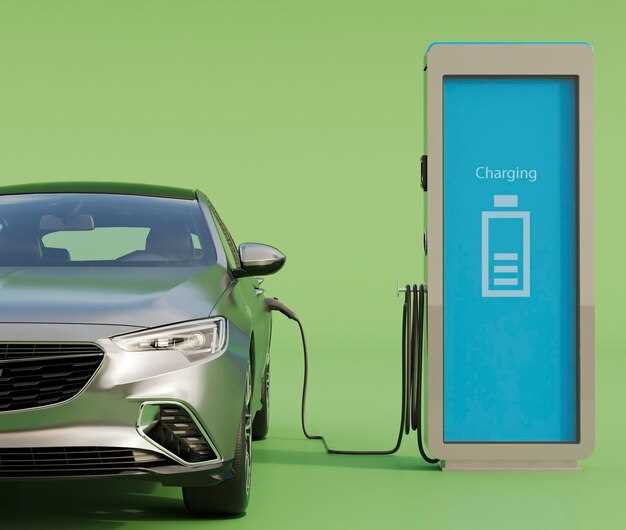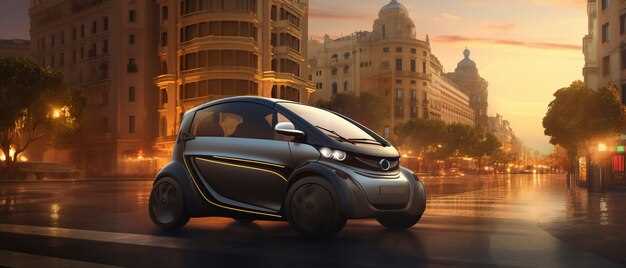Install fast chargers at strategic locations to ensure a seamless experience for electric vehicle (EV) drivers. Recent data indicates that the number of public charging stations has surged by over 50% in the last year, highlighting the growing commitment to expanding charging networks.
Consider investing in smart charging solutions. Technologies such as vehicle-to-grid (V2G) systems allow EVs to return energy to the grid during peak hours, balancing energy needs while providing additional revenue streams for owners. Cities adopting V2G technology show a noticeable increase in grid stability and reduced electricity costs.
Prioritize the implementation of ultra-fast charging stations. These chargers can provide up to 350 kW of power, enabling a full charge in under 30 minutes. Locations near highways and urban centers attract a wider audience, making long-distance travel in EVs more feasible and convenient.
Collaborate with local governments and businesses to enhance the charging infrastructure. Partnerships can facilitate access to funding, streamline permitting processes, and increase awareness about available charging options. Municipalities that engage in these collaborations often report higher usage rates of public charging stations and increased EV adoption.
Finally, stay informed about technological trends, such as wireless charging and solar-powered stations. These innovations not only improve user convenience but also align with sustainability goals, making EV charging a more eco-friendly solution. By adopting these strategies, stakeholders can significantly bolster the EV infrastructure and encourage more drivers to make the switch to electric.
Integration of Renewable Energy Sources in Charging Stations
Implement solar panels and wind turbines at charging stations to directly power electric vehicle (EV) chargers with clean energy. This strategy enhances sustainability and reduces dependence on grid electricity.
Evaluate potential sites for solar installations by analyzing sunlight exposure and local regulations. Pair photovoltaic systems with battery storage to ensure energy availability during non-peak hours. This maximizes the use of generated energy and decreases operational costs.
Implement incentives for users who charge during peak solar production times, thereby promoting energy consumption during optimal conditions. This creates a win-win scenario that benefits both users and operators.
Consider partnerships with local utility companies that offer programs supporting renewable energy integrations. Utilities may provide grants or technical assistance for the setup of green energy solutions.
- Use smart charging technology to optimize energy use. Implement demand-response systems that adjust charging power based on grid load.
- Encourage the installation of energy management systems to monitor and control power consumption at charging stations.
- Incorporate vehicle-to-grid (V2G) technology, allowing EVs to supply stored energy back to the grid during high demand, enhancing grid stability.
Track the environmental impact of using renewables at charging stations. Implement metrics to monitor energy savings, reduction in greenhouse gas emissions, and improvements in energy efficiency. Share these results with the community to promote transparency and encourage further adoption.
Continuously research and adopt emerging technologies in renewable energy to improve the performance of charging stations. Stay informed about advancements in battery technology and smart grid solutions to further integrate renewables efficiently.
Development of Ultra-Fast Charging Technologies
Ultra-fast charging technologies are transforming the electric vehicle (EV) market by significantly reducing charging time. Targeting a charging capability of 300 kW and above, these systems can recharge a vehicle’s battery to 80% in roughly 15-30 minutes. Companies like byd and Tesla lead the charge with their proprietary charging networks, ensuring widespread access and compatibility.
Implementing liquid-cooled cables addresses heat buildup during high power transfers, improving safety and efficiency. Utilizing advanced battery management systems enhances overall charging performance, ensuring optimal energy flow while prolonging battery lifespan. Investing in modular charging stations allows for scalable solutions that adapt to future power needs.
Collaboration between automotive manufacturers and charging infrastructure providers accelerates the innovation of ultra-fast charging solutions. Standardizing connectors like CCS and CHAdeMO promotes compatibility across various EV models, simplifying the user experience. Continuous research into alternative charging technologies, such as solid-state batteries and wireless charging, paves the way for even faster and more efficient solutions in the near future.
Localization of charging stations is essential for user convenience. Integrating ultra-fast chargers at strategic locations, such as highway rest stops and urban centers, ensures that drivers can quickly recharge on the go. Public-private partnerships can facilitate this expansion, spreading the benefits across communities.
Incorporating renewable energy sources into the charging ecosystem enhances sustainability. Solar-powered charging stations reduce reliance on fossil fuels, allowing users to charge their vehicles with cleaner energy. This approach aligns with global sustainability goals and can attract environmentally conscious consumers.
Monitoring and utilization of data analytics help in understanding user behavior and optimizing charging station locations. Smart grid technologies can dynamically manage power distribution, balancing demand during peak and off-peak hours. Selecting the right technologies and strategies will drive the transition towards faster, more accessible EV charging, catering to the growing demand for electric mobility.
Smart Grid Integration and Load Management Solutions
Integrate smart grid technology to optimize electric vehicle (EV) charging. Utilize real-time data analytics for monitoring energy demand, which enables precise load management. Employ demand response programs to adjust charging patterns during peak hours, minimizing strain on the grid and optimizing energy costs.
Implement advanced metering infrastructure (AMI) to monitor electricity usage and charging station efficiency. This data helps identify usage trends, allowing for better resource allocation and strategic planning. By optimizing charging times based on grid capacity, you can reduce energy costs and enhance the reliability of charging services.
Use energy storage systems in conjunction with EV charging stations. These systems store excess energy during off-peak hours and release it during peak demand. This approach balances the load and supports grid stability while providing an additional revenue stream through peak shaving.
Invest in vehicle-to-grid (V2G) technology, enabling EVs to discharge energy back to the grid. This creates a two-way flow of energy, enhancing grid resilience and making use of distributed resources. Incentivize EV owners to participate in V2G programs, providing rewards for returning energy during critical times.
Collaborate with local utilities to develop dynamic pricing models based on real-time demand. Charging costs can vary depending on time, enabling users to charge during low-demand periods. Transparent pricing encourages users to shift their charging habits, thereby alleviating pressure on the grid during peak consumption.
Participate in pilot projects to test innovative load management strategies. Collect feedback and data to refine these solutions for broader implementation. Engaging stakeholders and the community fosters support and enhances the viability of load management initiatives.
Expansion of Charging Networks in Urban Areas
Invest in fast-charging stations located in high-traffic areas like shopping centers and office complexes. These strategic placements significantly reduce charging times and enhance user convenience. For example, a recent study indicated that urban locations with high-density charging points saw a 30% increase in electric vehicle (EV) adoption.
Prioritize the integration of charging infrastructure in public transportation facilities. Buses can convert to electric power, supported by dedicated charging zones that minimize downtime. Implementing this can lead not only to cleaner air but also to more efficient public transit. Cities such as Shenzhen, which have already electrified their bus fleets, demonstrate this approach’s feasibility and benefits.
Encourage partnerships with local businesses to install charging stations in their parking lots. Create incentive programs for these businesses, like tax reductions or cost-sharing initiatives, enhancing their participation in EV infrastructure. This collaborative effort can expand access across various neighborhoods, particularly in underserved areas.
Utilize municipal land for installing charging hubs. Cities can convert underused lots or parks into EV-friendly spaces, promoting sustainable practices. For instance, recent projects in San Francisco have transformed parking lots into charging hubs, resulting in increased usage and community support.
Implement smart charging technology to optimize energy usage and costs. This involves integrating real-time data analytics to manage charging loads effectively, ensuring grid reliability while accommodating growing EV demands. Cities adopting these technologies have measured a noticeable decrease in operational costs associated with energy consumption.
Regularly gather feedback from users to enhance the charging experience continually. Surveys and app reviews can inform improvements in location accessibility, charging speed, and overall service quality, driving higher usage rates.
Innovations in Wireless and Contactless Charging Systems
Exploring wireless and contactless charging systems reveals a vast potential to enhance charging convenience for electric vehicles. This technology allows vehicles to recharge without physical connections, promoting seamless integration into urban infrastructure.
Recent advancements utilize resonant inductive coupling, effectively transferring energy between the charging pad and the vehicle. This method can charge cars parked over the charging pad, increasing accessibility in busy public spaces. According to a study by the International Energy Agency, these systems can achieve efficiencies of up to 90% under optimal conditions.
Companies like Qualcomm and WiTricity are leading the charge with systems that offer scalable wattages, enabling various vehicle models to benefit from wireless charging. Contracts for public installations have already been signed in cities like San Diego, which aims to equip city parking lots with this technology.
A significant innovation is the integration of wireless charging into roadways. Dynamic wireless power transfer systems can deliver charging while the vehicle is in motion, extending range and eliminating range anxiety. Trials in Europe have shown promising results, with potential implementations projected to begin in urban centers by 2025.
Contactless charging stations are becoming more widespread. They utilize infrared or magnetic resonance to transfer energy, allowing for diverse applications beyond personal vehicles, such as buses and taxis. This adaptability enhances public transport options and contributes to the reduction of emissions in urban areas.
| Feature | Wireless Charging | Contactless Charging |
|---|---|---|
| Efficiency | Up to 90% | Varies, typically lower than wireless |
| Mobility | Static (parked vehicles) | Dynamic (in-motion charging) |
| Use Cases | Private EVs, fleet vehicles | Buses, taxis, delivery vehicles |
As cities adopt these technologies, they pave the way for cleaner, more sustainable urban environments. Collaboration between governments and private sectors will expedite deployment, ensuring robust infrastructure to support the growing electric vehicle market.
Government Policies Promoting Charging Infrastructure Growth
Countries can incentivize the expansion of electric vehicle (EV) charging infrastructure through various targeted policies. Direct financial support, such as grants and tax credits, encourages private companies and municipalities to invest in charging stations. For instance, the U.S. government’s Federal Charging Station Grant Program provides funds specifically for developing public charging points.
Streamlining permitting processes is another effective strategy. By reducing bureaucratic barriers, local governments can expedite the deployment of charging stations. States like California have successfully implemented “one-stop-shop” permitting for EV infrastructure, significantly decreasing installation times.
Public-private partnerships enhance the effectiveness of infrastructure development. Collaborating with private sector players ensures better resource allocation and innovation. Evidence shows that cities leveraging such partnerships often see faster and more widespread charging networks.
Setting specific targets for charging infrastructure deployment creates accountability. Governments can establish goals, like the installation of a certain number of charging stations by a defined date, motivating stakeholders to take action. For example, the European Union aims for at least one public charging point for every ten electric vehicles by 2025.
Consumer education campaigns also play a significant role. Clearly communicating the benefits of EVs and available incentives promotes adoption. Countries that invest in public outreach tend to experience higher levels of consumer engagement and interest in EVs and charging infrastructure.
Local zoning regulations should support the installation of charging stations. Adjusting land use policies to allow for easier installation in residential and commercial areas can significantly enhance access to charging. This can lead to more convenient options for EV users and increased overall usage.
Lastly, incorporating charging infrastructure into urban planning processes ensures that it meets future demands. Cities should consider charging stations as integral components of their development strategies, anticipating growth in electric vehicle usage.
Implementing these recommendations creates a robust framework for expanding charging infrastructure, driving the transition to electric vehicles effectively.







